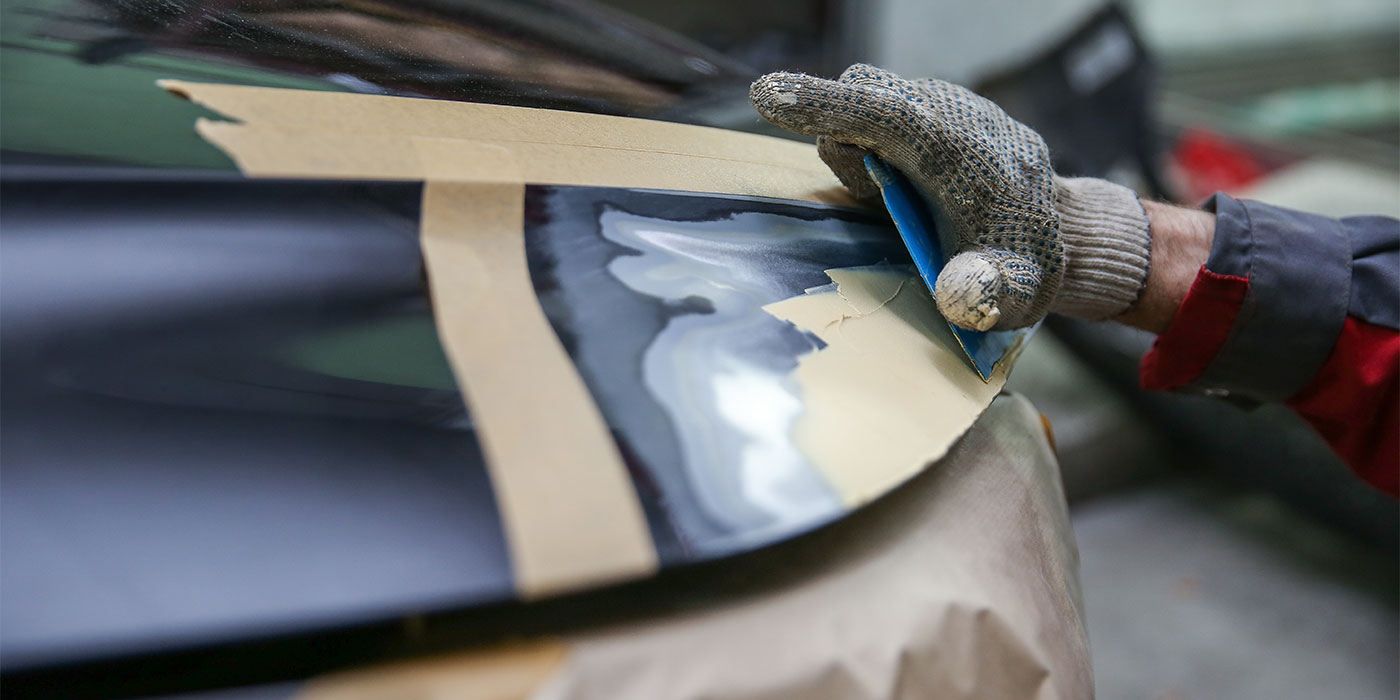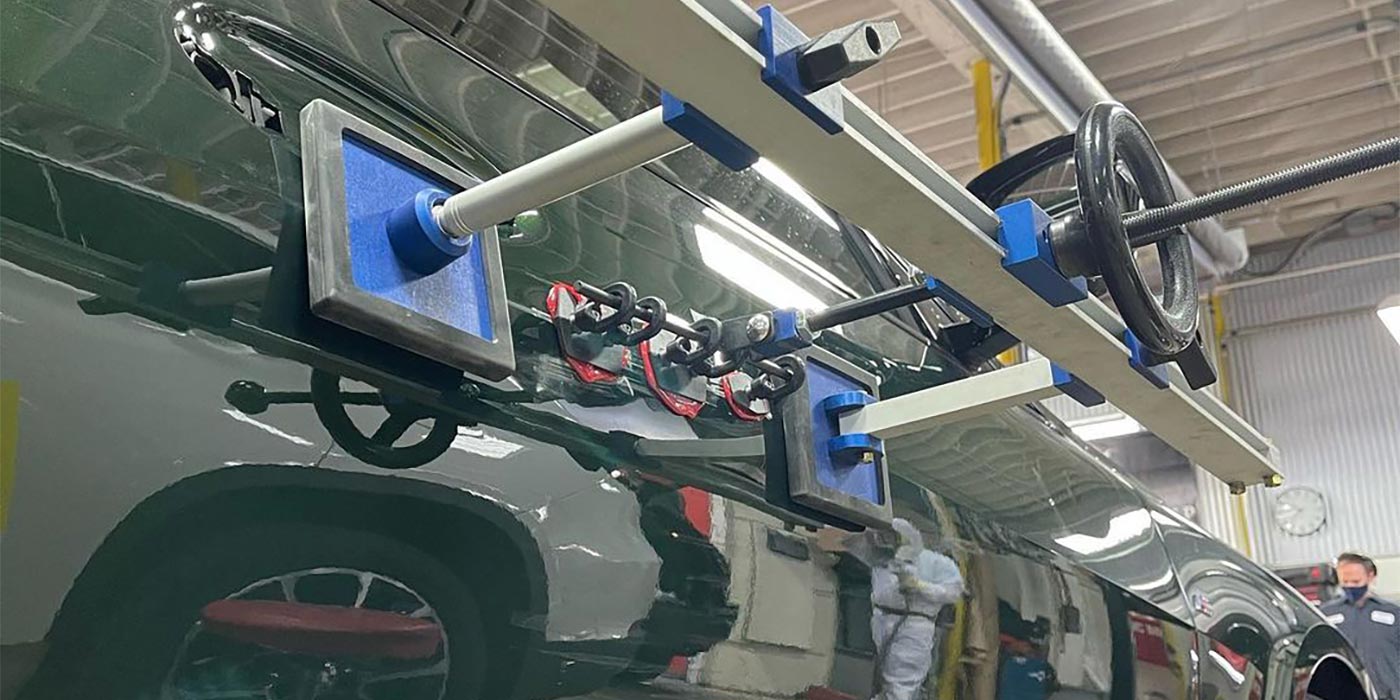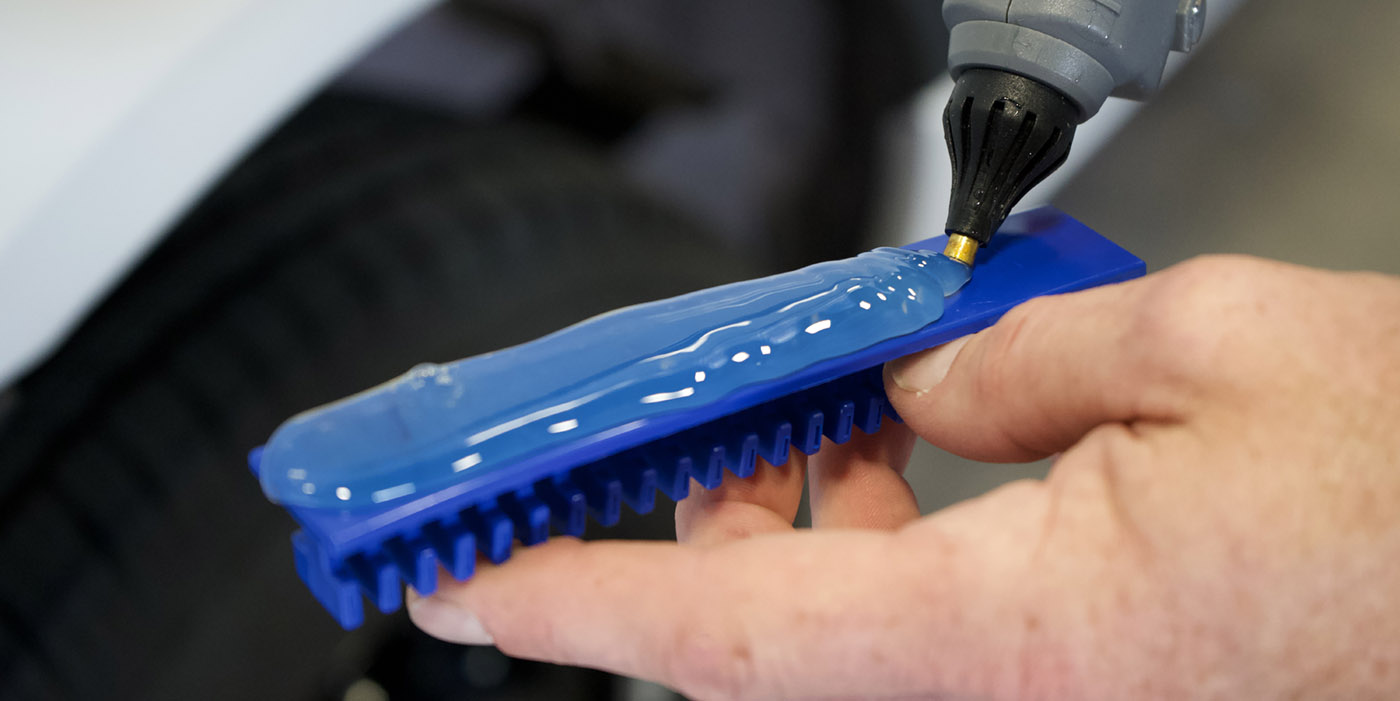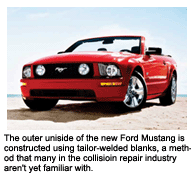
Question: In a recent I-CAR Advantage Online about collision repairs on the new Mustang, it says the Mustang has a “uniside constructed of tailor-welded blanks.” What is a tailor-welded blank?
Answer: In basic terms, tailor-welded blanks are new, one-piece “welded” parts created by constructing single parts from differing thicknesses or strength metals. The part may be stronger than a stamped part of a thinner steel, and it can be lightened in areas where high strength or crash resistance isn’t required to help maximize fuel economy.
The following is reprinted courtesy of the Auto Steel Partnership Web site www.a-sp.org — with some minor clarification of terms. It should explain the more esoteric elements of tailor-welded blanks, provided you understand engineering-speak.
Brief History and Purpose of Tailor-Welded Blanks
During the past two decades, government fuel conservation and safety mandates, along with environmental concerns, have prompted the American automotive industry to design lighter cars for reduced fuel consumption and to improve the overall structure of their vehicles for occupant safety. Consumer requirements for corrosion protection were also much improved during this period. These changes added to escalating manufacturing costs at a time when the industry was struggling with a threat from global competition.
To reduce weight and costs, alternative materials such as aluminum and composite materials have been used for body panels, but none has shown the versatility of steel. High-strength steels, coated steels, laminated steels and various drawing quality (ability to heat and pull through a form to shape a blank) grades give steel the ability to meet most automotive requirements.
One area of concern for product engineering, however, has been the higher density of steel versus alternative materials. The concept of combining various steel options into a welded blank was developed to enable product and manufacturing engineers to “tailor” the blank so that steel’s best properties were located precisely within the part where they were needed. This process not only reduces the weight of the finished part, but also can be used for part integration, thereby eliminating many reinforcements and stiffeners.
Potential Benefits of Tailor-Welded Blanks
The potential benefits of the tailor welded blanks are impressive:
- Fewer parts;
- Fewer dies;
- Fewer spot welds;
- Reduced design, development time;
- Lower manufacturing costs;
- Less material input, better utilization of steel;
- Weight reduction;
- Improved dimensional accuracy;
- Improved structural integrity;
- Improved safety;
- Increased offal utilization and reduced scrap;
- Most importantly, the ability to add sectional strength exactly where it’s needed on a specific part.
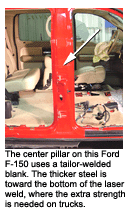
Common Types
Tailor-welded blanks are made from prime stock as nested blanks or from collectible offal. (Best description: trimmed but salvageable scraps.) Although the tailor-welded blank process was first developed as a method for utilizing collectible offal and improving blank nesting possibilities, its greatest potential lies in the area of tailor-welded blanks with different thicknesses, coatings and material grades. This type of tailor-welded blank gives the product designer the opportunity to eliminate reinforcements while improving structural and dimensional characteristics by directly varying the types of metal panels used to create a single part.
For example, tailor-welded blanks are currently used for body side frames, door inner panels, motor compartment rails, center pillar inner panels and wheelhouse/shock tower panels. In the near future, they’ll be used on more body parts due to the reduction in tooling and operating costs.
General Design Philosophies
Europe — One of the earliest European applications of tailor-welded blanks for automotive applications was by Swedish carmaker Volvo using the resistance mash seam process in 1979. Other European manufacturers (Volkswagen, SEAT) now use the resistance mash seam process for tailor-welded blanks and, for the most part, have concentrated their efforts on structural members such as motor compartment lower frame rails and wheelhouse/ shock tower assemblies.
A notable exception is the Audi floor pan, which has been laser welded by Thyssen AG in Germany since 1985. This represents the earliest known use of laser-welded blanks in Europe. The blank for this panel is laser welded due to the sheet steel maximum coil width available from the steel mill being less than the required blank size. Also, the maximum resistance mash seam weld length at that time was one meter (40 inches), which didn’t satisfy the design requirements of the 1960mm (77 inches) weld-joint length.
Japan — Toyota has been producing welded blanks by laser beam with and without filler wire since 1986. There’s no known use of resistance mash seam welding in Japan at this time. Filler wire is used for applications that have an exposed weld in the finished product, such as body side frames. (See “Laser Welding with a Filler Wire” and “Effects of Filler Wire on Weld Hardness” diagrams.) Filler wire welds are ground for flush appearance after welding.
Welds that don’t require a flush surface for aesthetic or sealing purposes are welded with Toyota’s beam-weaving process. Beam-weaving laser welding is a non-filler wire welding process that dramatically reduces the argon or nitrogen porosity of a welded union of two panels. This reduction of porosity dramatically improves the union strength, and the process minimizes the need for a precision-sheered joint.
Although beam weaving can reduce the weld’s concavity, it doesn’t replace the filler wire process for body side frames since it doesn’t satisfy the requirements for outer surface appearance. Both filler wire and beam weaving are used to reduce the need for precision shearing and to allow laser welding of multi-piece, multi-weld blanks in a one fixture set-up. Toyota, with in-house automated welding systems for both two-piece and multi-piece blanks, has been the leading innovator of these processes.
By using die-cut blanks without precision shearing before each weld, Toyota eliminates the repeated steps of shearing and welding and the inefficient batch processing that’s typical for multi-piece, multi-weld blanks made on other welding systems. Toyota is able to laser butt-weld blanks with a gap tolerance as high as 10% of the metal thickness when beam weaving, which allows them to weld die-cut edges. Based on their technical reports, this process appears to have a limit of a 500mm (20-inch) weld length.
North America — The initial use of tailor-welded blanks in North America has been on structural members such as frames, center pillar inners and motor compartment upper rails. Electron beam welds have been used to weld thicker gauge (3.0-5.0mm/0.12-0.20-inch) metal blanks for automotive frame members at AO Smith since 1968. More than 100 million welds had been made on tailor-welded blanks when production ended in 1993.
Laser beam welding is currently used on most of these applications. Resistance mash seam welded blanks have become more available recently and are increasingly being considered for automotive applications. Current planning by North American and European manufacturers indicates that resistance mash seam and laser beam welding will be used on future models. When more than one welding process meets the design requirements, availability and cost will be the deciding factors.
What All This Means to You
Collision repairers need to realize that a particular component may actually be an assemblage of dissimilar materials, and the straightening of these components may be far more difficult after a collision. It’s important to identify the unique repair-and-replace considerations these new components create to avoid creating additional damage to a component when pulling to straighten it. Most importantly, strength will not be uniform throughout the panel.
Writer Tim Ronak works with Akzo Nobel Coatings within the Acoat® selected division as a services consultant. He holds a degree in economics and management, and has worked in the collision repair industry for more than 30 years. He can be reached at [email protected] or [email protected].






